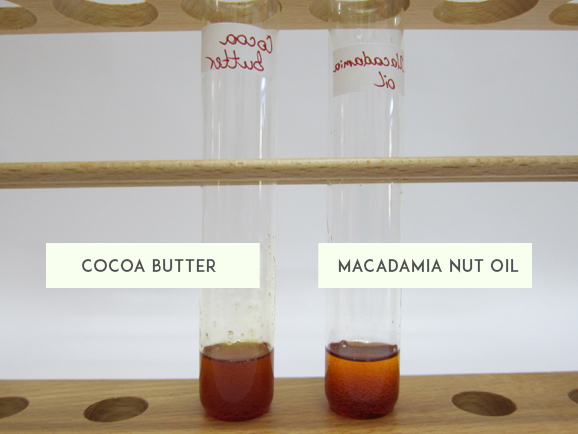As any cosmetic formulator knows, some plant oils are sensitive ingredients. Certain plant oils can have very short shelf lives and go rancid quickly. Heat particular oils for too long and you further reduce their shelf life. But as our students regularly ask us – how can you tell if your plant oil is heat sensitive?
When new students start with us on our Diploma in Organic Skincare Formulation, they are often puzzled by the vast difference in sensitivity between their rosehip oil (which sometimes has a shelf life as low as 3 months) and their coconut oil (which sometimes has a shelf life as high as 3 years). If they’re making an emulsion, they then learn to add their rosehip oil at the end of the formulation after all of the ingredients have been added, in order to avoid heating the oil and causing degradation of the ingredient. But why is rosehip oil particularly heat sensitive and why isn’t coconut oil?
In this article, we are going to look at fats in more detail and explain how their iodine value gives you an approximate idea of whether the plant oil is heat sensitive. We get lots of questions from our students about which oils are sensitive to heat or prone to oxidisation and thankfully there is a relatively easy way to tell.
Fatty Acids Decoded
Plant oils consist of various fatty acids which are the basis of any fat or oil we use. These fatty acids, which are the building units of plants oils, are combined in groups of three, hence the name triglycerides.
Fatty acids are composed of carbon atoms which have hydrogen atoms attached to them. The carbon atoms then form longer or shorter chains, we call these bonds. The chain length is a characteristic that defines melting point for instance. A lipid is normally a mixture of short, medium or long chains.
You have probably heard of fatty acids such as:
- Palmitic acid
- Linoleic acid
- Oleaic acid
- Stearic acid
Fatty acids can be grouped into saturated, monounsaturated (MUFA) or polyunsaturated (PUFA) fatty acids. As the name reveals, the MUFA has only one unsaturated carbon-carbon bond, the PUFAs have two or more unsaturated carbon- carbon bonds.
The higher the content of unsaturated fatty acids in a lipid, the lower melting point it has.
Butters and waxes for example, have a low content of unsaturated fatty acids whereas liquid oils have a much higher content of unsaturated fatty acids.
The higher the content of unsaturated fatty acids in a lipid, the lower the oil's melting point. #greenbeauty #cosmeticscience Click To TweetLet’s look at two common lipids and how they behave in different temperatures:
Macadamia Nut Oil - Fatty Acid Composition
Macadamia nut oil contains about 90% unsaturated fatty acids therefore it remains liquid even in winter.
Cocoa Butter - Fatty Acid Composition
Cocoa butter on the other hand, contains only about 37% unsaturated fatty acids and hence it remains solid at room temperature.
Why is this information important and what is the connection to the sensitivity of carrier oils?
Shelf-life and Stability of Plant Oils
Plant oils, like many other natural ingredients, have a lower shelf-life compared to synthetic cosmetic ingredients. In plant oils, their degradation is generally called rancidity. Rancidity happens via different pathways:
- Microbial rancidity
- Hydrothermal rancidity
- Oxidative rancidity
In any of these degradation pathways, the plant oil is degraded to components that change the scent, appearance and the texture/skin feel of the oil. You may have experienced the unpleasant odour of old cooking oil when you pass by restaurants or food trucks that do not change their frying oil as often as they should.
Both hydrothermal rancidity and oxidative rancidity are faster for oil with a higher degree of unsaturation (higher MUFAs and PUFAs). In other words, the higher the content of unsaturation, the more susceptible the oil to heat and oxidation and ultimately the shelf life will be shorter. You see this is why butters and waxes in general have a longer shelf life than some carrier oils.
Iodine Value: What is it and how does it work?
The iodine value is a characteristic of each fat, oil, butter or wax. It is a quantitative expression of its degree of unsaturation.
In standard laboratory procedure, a purple-brown coloured iodine solution is added to a lipid (oil, butter or wax) in order to calculate the oil’s iodine value. If the fatty acid in the oil has a double bond then it can incorporate the iodine. The amount of iodine absorbed by the oil tells us its degree of unsaturation.
In our experiment, we added iodine to macadamia oil and cocoa butter to demonstrate the way the iodine reacts with the fats. In this first photo you can see that iodine has just been added to the two ingredients:
When there are no unsaturated bonds in the lipid, the iodine remains intact and the solution remains purple-brown. When there are unsaturated bonds in the lipid, they react with the iodine and the mixture turns colourless. In this second photo you can now see that the macadama nut oil has completely changed colour:
See how the iodine changes colour in two different lipids?
This is a very simplistic way of demonstrating the iodine value but if you want to know the exact measurement then you will of course have to undertake a far more precise experiment to calculate the oil’s iodine value. The iodine value is defined as the weight of iodine (in grams) absorbed by 100g of the oil.
Shelf life and Iodine Value
The iodine value is a good determinant of stability and shelf life of the lipids we work with. However, please keep in mind that there is no rule of thumb or linear relationship between the iodine value of the oil and its shelf life. This is not an exact science, it just a helpful guide.
The shelf life, apart from the iodine value and the nature of the lipid, depends on many other factors such as extraction method, refined vs. unrefined oil, additives (antioxidants such as tocopherol or rosemary extract), storage condition and more.
Generally, we say that the higher the iodine value of your lipid, the more sensitive it is. It means you need to protect your raw material from light, oxygen and heat. When formulating, you should add these during the cool down phase. You should also remember that the higher the content of such lipids in your finished formulation, the more sensitive your overall product would be.
Want to learn more about stability testing and shelf life? Enrol for our Certificate in Cosmetics Stability Testing.
The Chemist's Guide to Checking Plant Oils for Heat Sensitivity - plus bonus table of 84 oils and their iodine value ranges #greenbeauty #cosmeticscience Click To TweetHeating and Iodine Value
When determining heat sensitivity of lipids, we need to consider many other factors such as presence of unsaponifiables (particularly tocopherols and carotenoids), temperature and method of extraction, origin of the oil etc. Our advice is that you should try to avoid heating oils with an iodine value higher than 100.
Thermal degradation of the fatty acid depends both on the temperature and the exposure time. This is why you need to avoid overheating your oils. You can heat your sensitive oil (if really necessary) for a very short period . Please do not use the heat and hold method when making emulsions.
Another point to note is that the iodine value is usually mentioned as a range in literature because the exact iodine value might vary from batch to batch and from harvest to harvest depending on the exact fatty acid profile of a given oil.
The iodine value is a characteristic of the lipid that is usually mentioned in its Technical Data Sheet or the Certificate of Analysis (not always in the Safety Data Sheet).
We’ve included a table with iodine value ranges of 84 different lipids, which will help you determine whether your plant oil is likely to show heat sensitivity.
| Common Name | INCI Name | Iodine Value |
| Acai fruit oil | Euterpe oleifera fruit oil | 60-90 |
| Andiroba oil | Carapa guaianensis seed oil | 65-75 |
| Apricot kernel oil | Prunus armeniaca kernel oil | 104-112 |
| Argan oil | Argania spinosa kernel oil | 96-99 |
| Avellana oil | Gevuina avellana seed oil | 137-147 |
| Avocado oil | Persea gratissima oil | 65-95 |
| Babassu oil | Orbignya oleifera seed oil | 10-17 |
| Bacuri oil | Platonia insignis seed oil | 50-65 |
| Baobab oil | Adansonia digitata see oil | 76-78 |
| Black cumin seed oil | Nigella sativa seed oil | 107-123 |
| Black currant | Ribes nigrum seed oil | 160-175 |
| Borage seed oil | Borago officinalis seed oil | 140-155 |
| Brazil nut oil | Bertholletia excelsa seed oil | 90-110 |
| Broccoli seed oil | Brassica oleracea italica seed oil | 90-120 |
| Buriti oil | Mauritia flexuosa fruit oil | 50-75 |
| Camelina seed oil | Camelina sativa seed oil | 124-153 |
| Camellia seed oil | Camellia sinensis seed oil | 80-87 |
| Castor oil | Ricinus communis seed oil | 81-91 |
| Cherry kernel oil | Prunus cerasus seed oil | 95-115 |
| Chia seed oil | Salvia hispanica seed oil | 190-199 |
| Cocoa butter | Theobroma cacao seed butter | 33-42 |
| Coconut oil | Cocos nucifera oil | 7-10 |
| Coffee seed oil | Coffea arabica seed oil | 76-101 |
| Coriander seed oil | Coriandrum sativum seed oil | 88-102 |
| Corn oil | Zea mays germ oil | 103-131 |
| Cottonseed oil | Gossypium herbaceum seed oil | 101-117 |
| Cranberry seed oil | Vaccinium macrocarpon seed oil | 140-180 |
| Cucumber seed oil | Cucumis sativus oil | 110-140 |
| Cupuaçu butter | Theobroma grandiflorum seed butter | 40-50 |
| Elderberry seed oil | Sambucus nigra seed oil | 170-190 |
| Evening primrose oil | Oenothera biennis oil | 147-155 |
| Flax seed oil/Linseed oil | Linum usitatissimum seed oil | 170-204 |
| Grape seed oil | Vitis vinifera seed oil | 123-143 |
| Hazelnut oil | Corylus avellana seed oil | 83-90 |
| Hemp seed oil | Cannabis sativa seed oil | 143-166 |
| Jojoba oil | Simmondsia chinensis seed oil | 78-90 |
| Kiwi seed oil | Actinidia chinensis seed oil | 180-220 |
| Kukui nut oil | Aleurites moluccanus seed oil | 136-175 |
| Macadamia nut oil | Macadamia ternifolia seed oil | 74-76 |
| Mango butter | Mangifera indica seed butter | 40-60 |
| Marula oil | Sclerocarya birrea | 70-80 |
| Meadowfoam seed oil | Limnathes alba seed oil | 90-102 |
| Moringa oil | Moringa oleifera seed oil | 65-72 |
| Murumuru butter | Astrocaryum murumuru seed butter | 10-15 |
| Mustard seed oil | Sinapis alba seed oil | 95-120 |
| Neem oil | Azadirachta indica seed oil | 65-85 |
| Olive oil | Olea europeae fruit oil | 78-90 |
| Palm oil | Elaeis guineensis fruit oil | 49-55 |
| Palm kernel oil | Elaeis guineensis kernel oil | 14-21 |
| Ojon oil | Elaeis oleifera fruit oil | 50-70 |
| Papaya seed oil | Carica papaya seed oil | 70-80 |
| Passionfruit seed oil | Passiflora edulis seed oil | 130-145 |
| Peach kernel oil | Prunus persica kernel oil | 94-110 |
| Peanut oil | Arachis hypogaea oil | 85-90 |
| Pecan oil | Carya illinoensis oil | 97-120 |
| Pequi fruit oil | Caryoca brasiliense fruit oil | 40-55 |
| Perilla seed oil | Perilla ocymoides seed oil | 196-206 |
| Pistachio nut oil | Pistacia vera seed oil | 86-101 |
| Plum kernel oil | Prunus domestica seed oil | 90-120 |
| Pomegranate seed oil | Punica granatum seed oil | 210-250 |
| Poppy seed oil | Papaver somniferum seed oil | 133-197 |
| Pracaxi oil | Pentaclethra macroloba seed oil | 90-105 |
| Prickly pear seed oil | Opuntia ficus-indica seed oil | 100-130 |
| Pumpkin seed oil | Cucurbita pepo seed oil | 113-134 |
| Rapeseed oil | Brassica campestris seed oil | 94-120 |
| Raspberry seed oil | Rubus idaeus seed oil | 160-195 |
| Rice bran oil | Oryza sativa germ oil | 89-108 |
| Rosehip oil | Rosa canina fruit oil | 152-169 |
| Sacha Inchi seed oil | Plukenetia volubilis seed oil | 183-199 |
| Safflower oil | Carthamus tinctorius seed oil | 140-150 |
| Sea Buckthorn berry oil | Hippophae rhamnoides fruit oil | 60-70 |
| Sea Buckthorn kernel oil | Hippophae rhamnoides seed oil | 130-200 |
| Sesame oil | Sesamum indicum seed oil | 100-120 |
| Shea butter | Butyrospermum parkii butter | 50-70 |
| Soybean oil | Glycine soja oil | 125-140 |
| Strawberry seed oil | Fragaria vesca seed oil | 175-190 |
| Sunflower oil | Helianthus annuus seed oil | 118-145 |
| Sweet almond oil | Prunus amygdalus dulcis oil | 93-105 |
| Tamanu oil | Calophyllum tacamahaca seed oil | 99-108 |
| Tomato seed oil | Solanum lycopersicum seed oil | 107-125 |
| Walnut oil | Juglans regia seed oil | 135-151 |
| Watermelon seed oil | Citrullus lanatus seed oil | 97-128 |
| Wheat germ oil | Triticum vulgare germ oil | 115-128 |
The iodine values in the table above were provided courtesy of SkinChakra. These values are extracts of the most reliable books, journal articles and data sheets. It is possible that you might stumble upon a book or a data sheet with a slightly variable range for a certain iodine value. The deviation should however be less than 20%.
We hope we managed to shed some light onto the sensitivity of plant oils and that these guidelines help you choose the right oils for the right type of formulation.
There are many wonderful oils on the market now, the sky is the limit.We encourage you try them, to experiment with them and continue creating more fantastic skincare formulations.
Read our previous articles:
- 10 Best Winter Carrier Oils
- 5 Amazonian butters for organic skincare
- 8 Best Oils for Botanical Oil Infusions
- Guide to choosing the best oils for Botanical Macerations
FAQs
Which carrier oil is best for sensitive skin?
Jojoba oil, which is in fact a wax but liquid at room temperature, is an ideal carrier oil to use in cosmetics aimed at sensitive skin. Jojoba oil has properties that align with our sebum and is widely accepted as a neutral, non-irritating and skin-tolerated carrier oil. Another soothing oil is calendula which is usually a macerate in sunflower or sweet almond oil. Oat bran oil is also ideal for use on irritated, dry and sensitive skin.
Leave us a comment

Dr. Elham Eghbali was Formula Botanica’s Cosmetic Chemist between 2014 and 2018. She has over 20 years’ industry experience and is based in Bavaria, Germany. To read more about Formula Botanica’s team, visit our staff page.






























